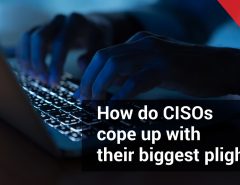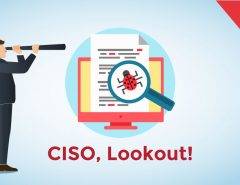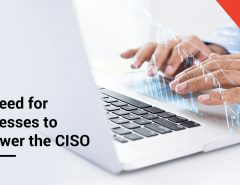With multiple ransomware attacks making the headlines, it is essential that the IT heads and concerned CISOs start treating cybersecurity as a mainstream topic. However, it is saddening to see that the sophisticated threats are continually outpacing the growth of safety standards, talented security professionals and the relentless uptick in training methodologies. These concerns along with a host of other worries are keeping the Chief Information Security Officers on their toes. It wouldn’t be wrong to state that advanced cybersecurity threats are often hard to detect even by the best of organizations. Majority of employees remain unprepared against hackers, which in turn compromises the data integrity of an organization. One such example was the phishing scam which transpired across the online domain via an embedded email which contained a malicious Doc file. Just imagine, if the hacker could procure a legitimate Google sign-in, how easy it would be for the more seasoned ones to inflict graver hits.
While the challenges above continue to plague the organizations, the onus is actually on the CISOs when it comes to reassessing the common concerns and devising a customized action plan for various security threats.
Dealing with the Financial Aspect
Almost every organization is on the constant lookout for trusted cybersecurity staff. While a majority of them would surely be interested in hiring cybersecurity unicorns, only a handful can afford their services. The Unicorns signify curious analysts that have ample experience when it comes to identifying endpoints, protecting perimeters and even scripting the prospective threats. Company CISO’s, therefore, need to worry about the security operations of an organization and address the staffing issues, accordingly. There are companies which find it hard to afford a complete security detail, and this is where outsourced services come in handy. Although CISO’s have a lot on their plate when it comes to deploying cybersecurity solutions, companies like Seqrite can make things easier for the former by proactively dedicating skills and time for ensuring operational security.
The Spread of Dark Web
Believe it or not, every bit of confidential organizational information resides on the Dark Web. Hackers leverage the tools and skill set available out there for initiating devastating attacks. This is why CISOs need to be extra careful when it comes to tracking the predators and prospective threats. Put simply, the mean time for threat detection across a network is usually 200 days, and within this timeframe, hackers can steal data or damage the concerned network. This anomaly prompts CISOs to undertake ‘Proactive Threat Hunting’ which signifies monitoring the dark web for irregular traffic patterns and potential threats.
Compliance vs. Security
Quite often, being compliant with the existing legislations minimizes the emphasis on the underlying security standards. However, the financial constraint is a deciding factor when it comes to striking the perfect balance between security and compliance. While compliance urges an organization to implement a firewall for segmentation, the concept of security is slightly more convoluted and involves employee training, risk assessment, and even an incident response plan. CISOs need to find a way to achieving both which can be a tiresome process if the organization has limited financial reserves.
Handling Company Reputation
There are times when data loss isn’t the only concern for the organizations. A company that has been previously attacked by a hacker loses a lot of credibility and reputation. Malware infections and ransomware threats can interfere with the fiduciary responsibility of an organization which aims at safeguarding the confidential data sets. CISOs, therefore, have a reputation to protect while keeping the hackers and attackers, off-limits.
Interconnected Devices and Lingering Threats
With technology playing a pivotal role in organizational growth, it is crucial to assess the unforeseen risks that plague automated gadgets, employee devices, and even the IoT essentials. CISOs should implement strategies that work beyond the usual realms of networking. Embedding cybersecurity services into products, supply chains, and enterprise devices is an approach that can maintain data integrity without entirely depending on the traditional strategies.
With cybersecurity threats looming large, majority of commercial businesses, critical infrastructure, and government agencies are under the radar. Therefore, each one of these organizations need to concentrate better on network visibility, cybersecurity services, company reputation, compliance, enterprise devices and a host of other factors. Once these security issues are taken into account, it becomes easier for the CISOs to formulate strategies; thereby enabling them to sleep better.
As an IT security partner for your business, Seqrite provides comprehensive endpoint security from advanced cyber threats. To know more, visit our website or




